Score:
84%
Released last year, this is the 'Nokia Digital Radio Headset DAB', a (now) £23 accessory that turns any 'USB on the go' Symbian handset into a full-on DAB radio. It works surprisingly well, too - amazing, given the size and cost of the first DAB radios. For the confirmed digital radio fan with a modern Symbian smartphone, at this price it's something of a must-buy, in my opinion. And you get a decent in-ear headset with full multimedia music controls into the bargain...
Buy Link | Download / Information Link
NB. DAB is the digital radio standard in the UK, Australia and some other Asian and European countries, see Wikipedia for more on the technology.
The idea behind the Nokia DAB is fairly simple - shrink the guts of a DAB radio (microprocessor, decoder, tuner) into as small a box as possible and then use all the resources of the phone for the rest. Display/interface, speaker, battery. The aerial is the supplied in-ear stereo headset, meaning that, combined, we have all the bits we need for a working digital radio. Moreover, it's integrated into your smartphone experience, so what's not to like?
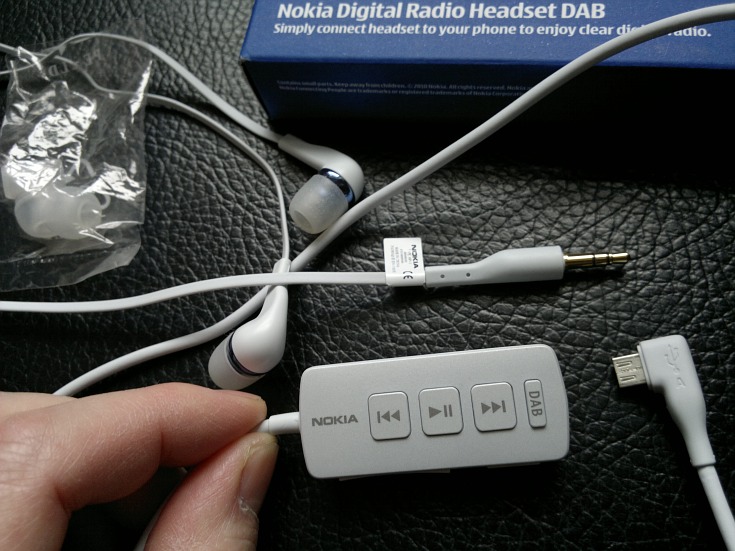
The DAB pod itself is only fractionally larger than some of Nokia's previous multimedia headsets (i.e. those with full media controls), with a clip on the back for attaching to a pocket or jacket lapel. Along the right side are call pickup and volume buttons, while down the main face are 'DAB', to switch between DAB functions and normal Music player output, plus generic media controls. In Music player mode, these function as normal; in DAB mode, the play/pause one isn't used, and the other two skip backwards and forwards through your DAB channel list.
The DAB pod itself plugs into the 'USB on the go' port on any Symbian^3 (and upwards) handset, so we're talking N8, E7, C7, 701, E6 and so on. The right angled design of the plug means that it doesn't protrude too far from the phone, although it also gets in the way of holding the phone cleanly - but this is a personal thing and not too much of an issue.
The in-ear headset supplied is of typical Nokia high quality and I had no complaints in terms of audio quality. Rather disingenuously, the box for Nokia DAB refers to "background noise isolation", perhaps implying some kind of electronic system, when it really just refers to the way the earbuds are in-ear and thus fill the ear canal.
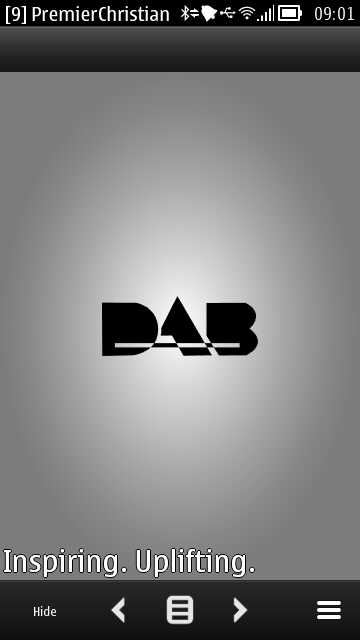
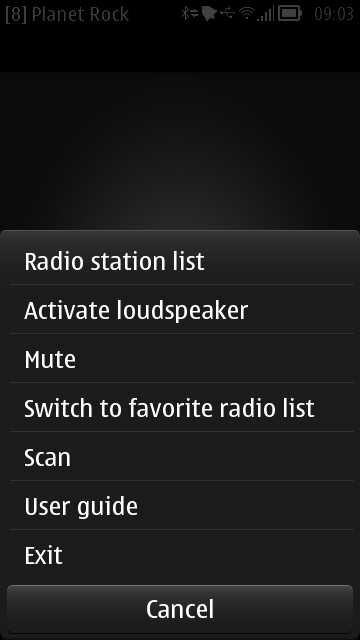
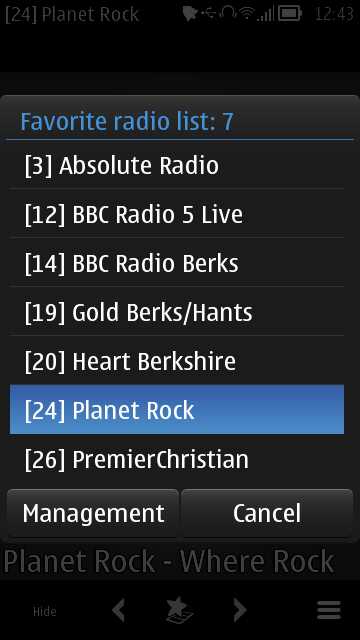
Rather curiously, the software that needs to be run at the Nokia end is currently missing in action on Nokia's servers, but it's all over the Internet as a quick and easy download, I got mine from here, for example. The filename you need (to type into Google) is Nokia_DAB_Radio_v2_5_19.sis.
On launching, the DAB application checks for the pod and then auto-scans for stations in your area, which takes up to ten seconds. And that's it, the first in the list starts playing and you can then step through them in various ways. The on-screen arrows mimic the hardware back/forwards buttons on the pod, the central 'list' icon goes to the main stations list (of which more below), there's 'Hide' so that you can send the whole shooting match to the background so that you can enjoy DAB music while you use other phone applications, plus a traditional 'More' menu, with results shown above, centre.
As with the built-in FM radio on most phones (which also use the headphone cable as an aerial, albeit plugged into the 3.5mm jack), as long as you leave the pod and headset plugged in, you can turn on the phone's speaker, turning the combination into a real 'audible by all' DAB radio, even though it's limited a bit by the quality of the phone's speaker, of course.
By default, the stations list is complete, but you can toggle this to just 'favorites' (above right), wherein you pick the stations you want displayed in a 'Management' dialog and thereafter you can cycle between just these. With up to 50 stations available in some areas, this is a system that works well when the phone is in your pocket, when you're just controlling the Nokia DAB using the pod and have no interface that's to hand.
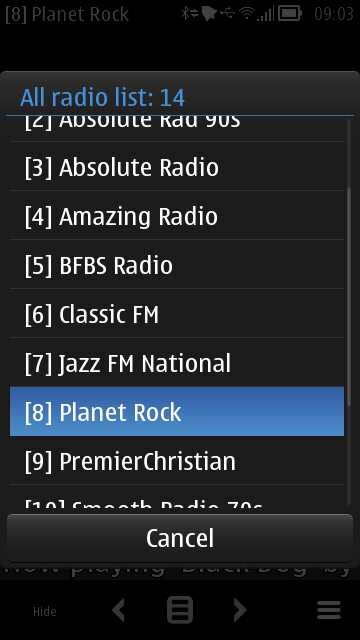
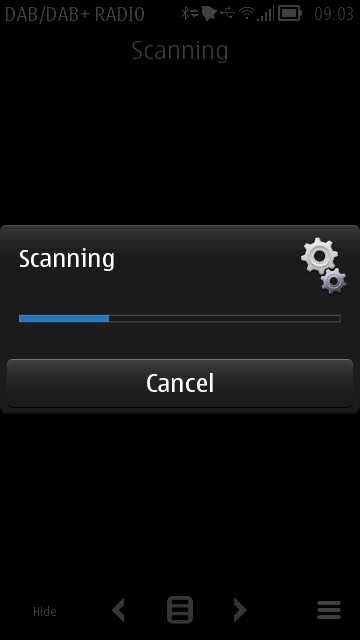
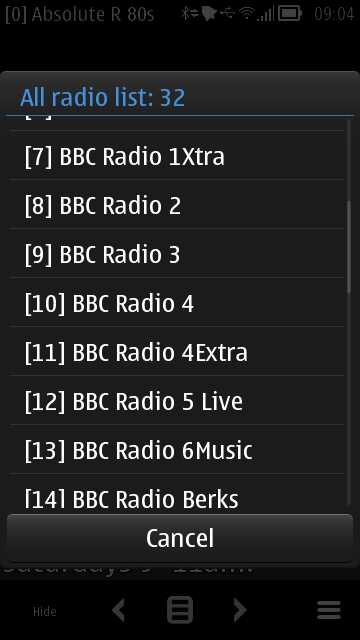
DAB quality versus FM is typically analagous to CD versus tape or vinyl - you get a much cleaner sound with no hiss, distortion or glitches, but as with any digital music you get a certain amount of compression artefacts if you listen very closely - for most music and spoken word it's appreciably better, in my opinion. Where FM signals degrade gradually when in a weak signal area, DAB (in typical 'binary' fashion) stays perfect right until the bit error rate gets too high, at which point it falls flat.
As with traditional radio, DAB radio comes from regional transmitters, with the difference that the stations are grouped in batches ('multiplexes') - essentially each batch is specially encoded in a single high bitrate digital stream and the DAB radio then strips out the station audio that it needs. In practice, this means that the number of stations available will go up in large increments.
In the screenshots above, I started off with 14 stations available, the contents of just the strongest digital stream (or two) from my local DAB transmitter. I then extended the headphone lead in a straight line, upstairs in the house, to give it maximum receiving ability and then used the 'Scan' function again. Hey presto, two more multiplexes were then detected and the number of stations rose to 32, including the all important 'BBC' one (in the UK). Note that if you have a station in your list and you then crumple up your headset or move to an area with worse reception, the station will still be 'tuned' to but the bit error rate will be high, you'll be warned and you may hear partial audio only.
Having the DAB pod and headset plugged in may all seem a little inconvenient, but bear in mind that for mobile listening of any kind you'd almost certainly have a stereo headset and controls plugged in anyway. And the Nokia DAB can take over general playback functions too - exit the DAB application and fire up Music player and all the control buttons then work as expected, for listening to music and podcasts. At any point you can then press the 'DAB' button to launch the DAB application and resume radio listening - though, curiously, you can't then press it again to turn off DAB functions and return to Music player. Ah well.
It goes without saying that DAB decoding circuitry is going to be more power hungry than a simple pass-through headset with controls, but the pod doesn't get very warm when in use and unless you spend hours listening to digital radio I doubt there will be significant impact on your phone's battery life. Most Symbian phones get through the day easily - spend an hour listening to the Nokia DAB and it might make your nightly recharge doubly essential.
As with any DAB radio gadget, all of the above is subject to the vagaries of where you live - there are still plenty of areas even in the UK which get poor DAB signal, sometimes one multiplex or none at all. In Berkshire, UK, I had no issues with the thirty-odd stations listed above, right.
At the original £50 or so, the Nokia DAB was a little pricey and only for hard core DAB and Symbian gadgeteers. At this price (currently £23), the unit is an absolute steal. Provided you can get good DAB Signal, you'll have a great experience with some superbly clean music and chat. And no reliance whatsoever on mobile data, which can safely be left off completely (unless you need it for other reasons) - all the DAB station data is transmitted over the air along with the audio.
Recommended.
Steve Litchfield, All About Symbian, 28 February 2012
Reviewed by Steve Litchfield at
No hay comentarios:
Publicar un comentario